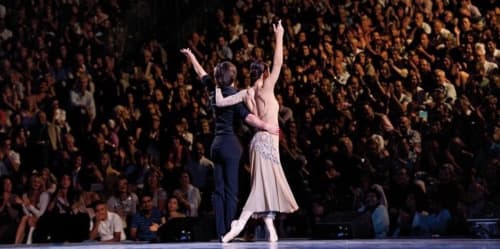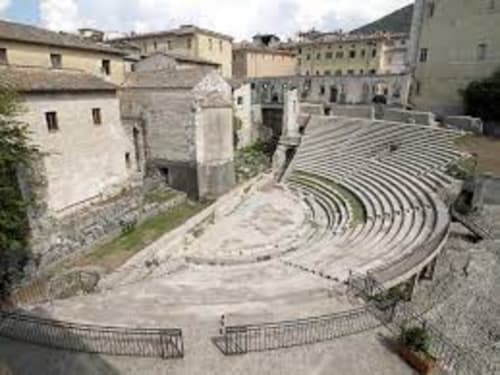Cattedrale di S.Maria Assunta 'The Cathedral'
The Duomo of Spoleto, 'The Cathedral' dating from the 12th century, features a lovely Romanesque façade and a magnificent fresco by Fra Filippo Lippi. Its official name is Cattedrale di Santa Maria Assunta (Cathedral of the Assumption of St. Mary)
- Piazza del Duomo, Spoleto, Province of Perugia, Italy-
Il Ponte delle Torri
The Ponte delle Torri bridge is an imposing bridge, about 230 metres long and 80 high, made from local limestone and adjoining Sant'Elia hill and Monteluco.
It can be reached from Piazza Campello by heading down Via del Ponte, which runs alongside the wall of the Rocca Albornoziana fortress.
La Rocca Albernoziana e Museo Nazionale del Ducato
ROCCA ALBORNOZ AND MUSEUM OF THE DUCHY OF SPOLETO
'The Rocca Castle' is a mighty fortress that is perched on Colle Sant’Elia, the highest point in Spoleto. Dating from 1359, it is one in a series of fortresses commissioned by Pope Innocent VI, then in Avignon, to reaffirm the pontiff’s authority over that part of central Italy that was under papal rule. "Lucretia Borgia governed Spoleto for a period of time" ...
- Association Rocca Albornoziana, Piazza Bernardino Campello, 1, Spoleto, Province of Perugia, Italy -
Teatro Romano / Museo Archeologico Nazionale
The Roman Theatre was built in the 2nd half of the Ist century BC;
In Roman theatres, the orchestra used to be the central, half-round space destined for special guests among the audience, and not for the choir like in Greece. This area still maintains some of the original, many-coloured IVth-century marble slabs that were imported from various regions of the Empire. White, dark and yellow slabs are placed around three green discs at the centre. In the Middle Ages, the set was dramatically altered by the construction of the church of Sant’Agata.
Nowadays the theatre and the State Archaeological Museum are melt together in a single complex and the theatre itself is still used for summertime shows, especially during the Festival Of Two Worlds; access to the site is in via Sant’Agata, but you can catch an overall glimpse through the big window in piazza della Libertà.
Indi: Via delle Terme/Piazza della Libertà
Access of State Archaeological Museum in Via Sant’Agata 18a
Tel: 0743 223277
For opening times and fees, please visit Spoleto Card
Casa Romana
The Roman House is an example of a noble residence from the early imperial age; the style of the frescoes, mosaics and the type of masonry place the Roman House in the first century AD.
The first excavation campaign aimed at its discovery was carried out by Spoleto archaeologist Giuseppe Sordini between 1885-86 and excavations continued until 1914.
During the excavation, an inscription was found, with a dedication by some …Polla to emperor Caligula; this led to think that the house belonged to Vespasia Polla, mother of Vespasiano, born in Norcia and owner of properties in the area between Norcia and Spoleto.
The domus dates to the I century AD and its spaces still maintain, besides the very beautiful floor mosaics, the typical layout of patrician houses between the end of the Republican period and the beginning of the Empire.
In via Visiale, between via del Municipio and via Saffi, there stands the Roman House, just above the Roman Forum.
Its privileged position, close to the ancient Roman Forum - today's Piazza del Mercato - and the richness of its decorative elements suggest that the owner was a very prominent figure of the time.
15 BC, fl 1st century AD) Vespasia Polla was the mother of the Roman emperor Vespasian, and grandmother to the emperors Titus and Domitian.
- Via di Visiale, Spoleto, Province of Perugia, Italy -
Diocesan Museum and Basilica di Santa Eufemia
The church arose inside the walls of what once the palace of the Lombard-ruled Dukes of Spoleto, which became the archbishop's palace. The titular saint was said to have lived at this site. A church at the site is recalled as being present around the 8th to 9th centuries. A Benedictine monastery adjacent to the church dates to the 10th century. By the 12th-century, the church was encompassed by the Archbishop's Palace.
The original tryptich that was once found in the main altar is now in the Diocesan museum. The frescoes in the apse ceiling depicting the God the Father and cherubs, dates to the 15th century.
- Via Aurelio Saffi, 06049 Spoleto, Province of Perugia, Italy-
Palazzo Collicola and Art Museum
Palazzo Collicola was built between 1717 and 1730 in the square by the same name, on a project by Roman architect Sebastiano Cipriani, thus commissioned by cardinal Francis Collicola, in a period when the family was experiencing dramatic economic and social progress. The original project was based on a sober horseshoe-shaped layout, that remained incomplete, hence the present L shape. This imposing palace featured 110 rooms on three levels, besides basement and attics.
The main façade towers over the square and is faced by a fountain hat leans against the building that used to host the stables; the inside overlooks a courtyard that was once an Italian garden with a central fountain surrounded by flowerbeds showing the owners’ coats-of-arms; the garden is scheduled for being recreated. The gallery at the piano nobile features a wide glass wall on the side of the courtyard, and other walls decorated with tempera, remarkable samples of performing skills and of illusionist virtuosity that was typical for the trend of the time, aptly described in art history as barocchetto or proto-rococò. The other rooms of the palace are also interesting and showcase coffered ceilings, either painted with garlands or sculpted with golden fretworks and under-ceiling friezes, decorated doors, high socles and windows intradoses.
In 1939, the Town Council bought the palace at auction, including most of the furniture. Past long and complex restoration works, in 2010 the site finally became the core of the city’s museum system.
Palazzo Collicola hosts the G. Carandente Modern Art Gallery, that was established starting from the early ’50s
The Piano nobile is a faithful reconstruction of an XVIIIth-century noble dwelling featuring furniture that was both already present in the original apartment, and coming from elsewhere, though dating to the same period. The Pictures Gallery exhibits painting dating to the XVth–XXthcenturies.
During the year, Palazzo Collicola features temporary exhibitions of modern and contemporary artists.
The Palace also hosts the Giovanni Carandente Library, a remarkable collection of more than 30000 volumes on contemporary art.
- Piazza Collicola, 1, 06049 Spoleto, PG, Italy -

























